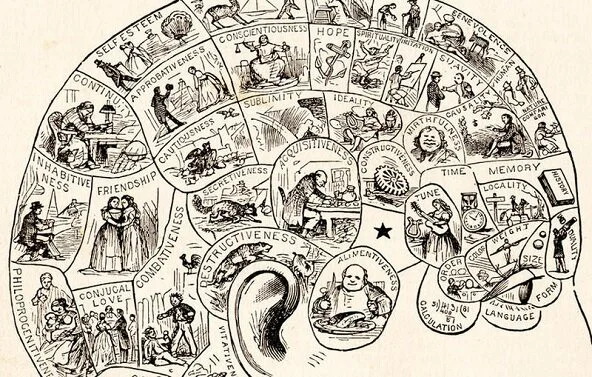A delightful looking and sounding noun, and an alternative to bumpologist, this is a humorous, gently derogatory mid-19th-century word for a practitioner in the highly dubious, once-popular pseudoscience of phrenology. But how can we relate that to the world of song?
Get measure of the man
Phrenology grew from the theories of the idiosyncratic German German neuroanatomist, physiologist and craniologist Franz Joseph Gall (1758-1828). While his brain studies contributed to brain science in other ways, one particular area of his studies led to phrenology. It came on the basis that the brain is the organ of the mind, and that organ is composed of multiple distinct, innate faculties, and characteristics, and as the skull takes its shape from the brain, it’s outer surface is therefore measureable as an accurate indicator of psychological aptitudes and tendencies.
A French cartoon depicts phrenologist putting heads together
In other words, examine the shapes and the bumps, and this will tell you all you need to know. The big flaw, among many others in that theory, is that it was eventually used by Gall and others not as true study, but as simply confirmations of hypotheses, and ignoring contradictory evidence. It was also an excuse for a whole spectrum of racism and prejudice.
Phrenology is all things to all men
A full definition from Webster's Academic Dictionary, 1895.
Boneheaded theories included those of, for example, Broussais, a disciple of Gall, who proclaimed that Caucasian people were the "most beautiful", while African, Australian Aboriginal or Maori would never attain a level of civilised society since they had no cerebral organ for producing great artists.
This prejudice is brought to life in a chilling and powerful scene in Quentin Tarantino’s Django Unchained, in which Leonardo Di Caprio, playing cruel, slave-trading plantation owner, expresses this theory to two silently disgusted visitors.
Phrenology’s influence waxed and wained throughout the 19th century, particularly in Britain and America, and leading voices including George Combe and the American "phrenological Fowlers”. In phrenology's initial heyday in the 1820s-1840s, many employers could demand a character reference from your local quack phrenologist to check on certain characteristics, such as whether they might be honest and hard-working. How this could be attained when all people have entirely varying head shapes, who knows. This belief that the protuberances on the skull provided an accurate index of talents and abilities was particularly urged to be applied to education and criminal reform. Some took it to a level of comical absurdity.
From Vaught’s Practical Character Reader
Despite the progress of serious science, the British Phrenological Society (founded by L.N. Fowler in 1887) was only disbanded in 1967.
Looking then at the history of music alone, and the extraordinary number of artists and talent with heads and bodies of all shapes is more than ample evidence alone of the ignorance of these bumposophers and their bumpologisms. So let’s have a look at a few artists who touch on this, even if this week’s word doesn’t appear directly in lyrics.
They Might Be Giants are always a rich source of lyrical limb stretching, and it is no surprise to find them parodying phrenology in their song Contrecoup:
You know what's wrong with me
You know phrenology
You saw my injury
You can tell just by looking at my skull
The peerlessly brilliant live band hip hop band The Roots brought out an entire 2002 album that frames prejudice through the prism of Phrenology, that being its title. Not all the songs are directly about that, but it includes great guest appearances from the likes of Cody Chesnutt, Musiq Soulchild, Talib Kweli, and Jill Scott. Here’s an example:
The Roots – Complexity (ft Jill Scott)
The more theatrical, actorly Aurelio Voltaire goes for the bumps in his devil-themed When You're Evil from The Devil's Bris album:
I'm the fly in your soup
I'm the pebble in your shoes
I'm the pea beneath your bed
I'm the bump on every head
Meanwhile Radiohead's Morning Bell from the Kid A album also focuses on head bumps and psychological problems with their own original sound:
You can keep the furniture
A bump on the head
I'm howling down the chimney
Release me
Finally, Austin, Texas’s alt-rock band …And You Will Know Us by the Trail of Dead, is not a regularly shaped name, nor is this song title, Half of What, but it does address the study of phrenology or bumposophy, more particularly, with the two halves of the brain referenced.
The shape of your head is a twist of the truth
The skulls on these walls, are they connected to you?
The stars are like eyes climbing out of a mist
The temperatures rise like an easter morning sun
It's not something you learn it's just something you do
And sometimes I wonder whether my other half is you.
So then, do any more bumposopher or phrenologist references take shape in your music collections or from elsewhere? Please feel free to share any further examples in songs, instrumentals, on albums, film, art or other contexts in comments below.
You can also get in touch the contact page, and also visit us on social media: Song Bar Twitter, Song Bar Facebook. Song Bar YouTube. and Song Bar Instagram. Please subscribe, follow and share. New to comment? It is quick and easy. You just need to login to Disqus once. All is explained in About/FAQs ...
Please make any donation to help keep Song Bar running:






